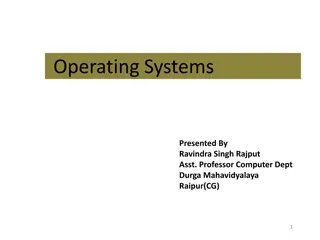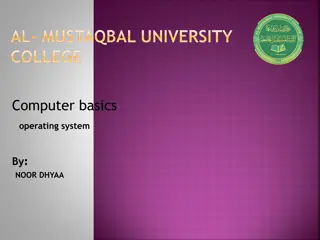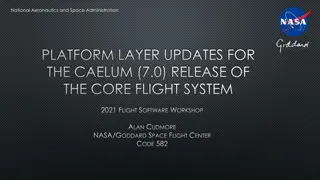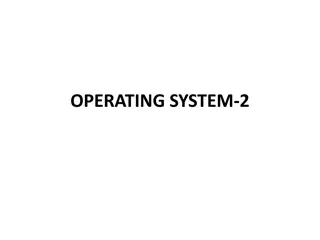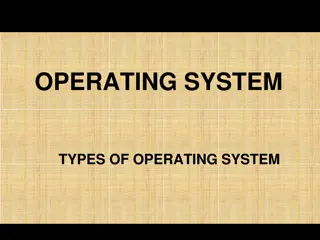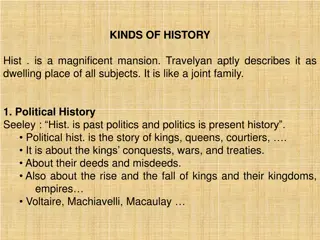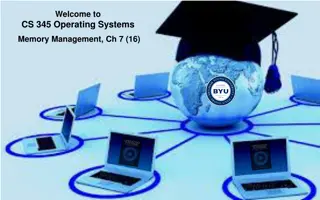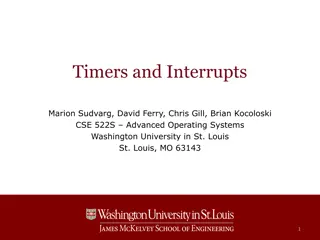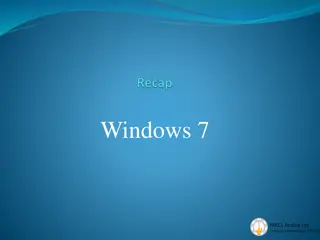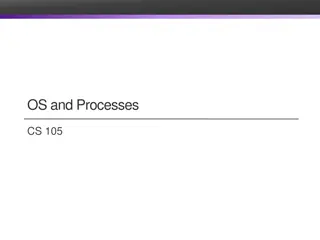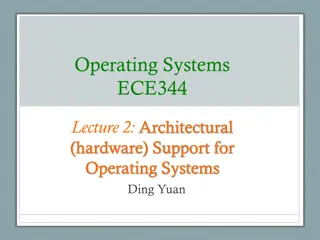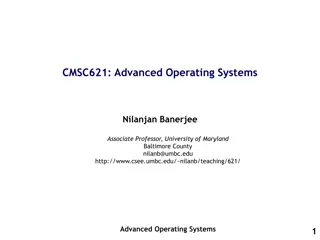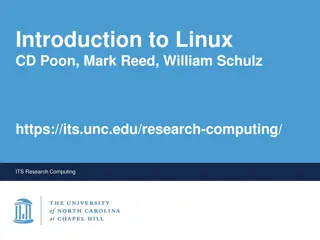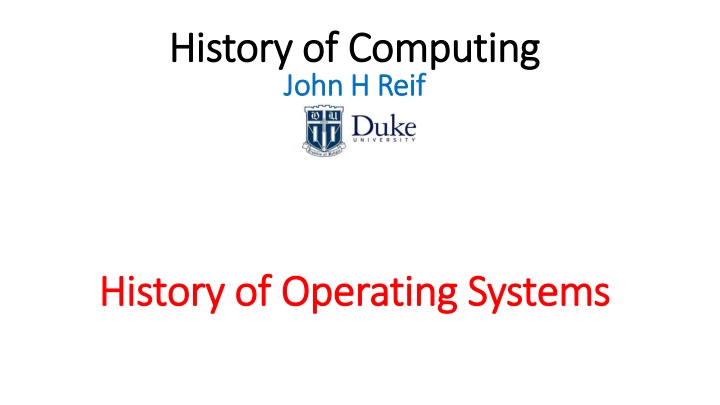
Evolution of Operating Systems: From Early Mainframes to Unix Systems
Discover the fascinating history of operating systems, from early mainframes in the 1940s to the development of Unix by Ken Thompson and Dennis Ritchie in 1970. Learn about the evolution of operating system structures, including batch processing systems like OS/360 and the portable and highly modular Unix OS. Explore the innovative features of Unix, such as its unified filesystem, shell scripting, multitasking capabilities, and modular inter-process communication mechanisms.
Download Presentation

Please find below an Image/Link to download the presentation.
The content on the website is provided AS IS for your information and personal use only. It may not be sold, licensed, or shared on other websites without obtaining consent from the author. If you encounter any issues during the download, it is possible that the publisher has removed the file from their server.
You are allowed to download the files provided on this website for personal or commercial use, subject to the condition that they are used lawfully. All files are the property of their respective owners.
The content on the website is provided AS IS for your information and personal use only. It may not be sold, licensed, or shared on other websites without obtaining consent from the author.
E N D
Presentation Transcript
History of Computing History of Computing John H John H Reif Reif History of Operating Systems History of Operating Systems
History of Computing History of Computing Operating Systems Operating Systems Topics of this Lecture on History of Operating Systems: Definition of an Operating System Early Operating Systems Unix Operating Systems MS DOS Operating Systems MS Windows Operating Systems Ken Thompson and Dennis Ritchie, principal developers of AT&T Unix [1973] Version 7 Unix, the predecessor of all modern Unix systems.
History of Computing History of Computing Operating Systems Operating Systems Early computers in the 1940s required every program to provide: Specification of hardware that was to be run. Drivers for peripheral devices such as punched paper card readers, magnetic tape readers/writers and printers. In the 1950s, computer systems began to have a suit of software that provided the above, as well as software to schedule multiple jobs: Operating system (OS): computer software that provides: A complete specification all hardware associated with the computer: Drivers for all peripheral devices. Software to control, schedule and synchronize the computer hardware. OSs for early Research Computers: An OS seem to have been developed for some of the early research machines, but there is little documentation. Early OS for Mainframes: Some operating systems for early IBM mainframes were produced by customers. 1st OS for a commercial mainframe computer [1956]: General Motors' GM-NAA I/O, an OS for its IBM 704. Fred Brooks OS/360 [1964]: a batch processing OS for the IBM 360. The most famous early OS. Developed at great cost and delay for its new IBM 360 Mainframe one of the great classic disasters of software development. Described in: Fred Brooks, The Mythical Man Month [1975] now a classic in software engineering. Later IMS OSs: IBM developed a series of later OS for subsequent mainframe computers, each more complex than the last, with little modularity in the OS software.
History of Computing History of Computing Operating Systems Operating Systems Ken Thompson & Dennis Ritchie s AT&T Unix OS [1970]: Derived from experience at MIT s Multics time-sharing OS. Originally implemented for a Digital Corp PDP-11. Ken Thompson (sitting) and DeRitchie (standing) running Unix on a PDP-11 Ken Thompson and Dennis Ritchie, principal developers of AT&T Unix [1973] Unix was the 1st portable OS: Mostly written in the C programming language, Allowed Unix to operate on numerous platforms. Unix OS was highly modular Unix philosophy: OS should provide simple tools, Each with a limited, well-defined function. Later Unix OS versions provided multitasking and multiusers. Unix OS structure: Version 7 Unix, the predecessor of all modern Unix systems. Unix filesystem: unified filesystem. Unix shell: shell scripting and command language. a sophisticated command-line interface. Unix pipes: a modular inter-process communication mechanism.
History of Computing History of Computing Operating Systems Operating Systems Unix OS structure: Ken Thompson and Dennis Ritchie Example Unix File System: Unix filesystem: unified filesystem. Unix shell: shell scripting and command language. a sophisticated command-line interface. Example Unix Shell: Unix pipes: a modular inter-process communication mechanism. Unix Command Line Pipes Example Unix Pipes:
History of Computing History of Computing Operating Systems Operating Systems Subsequent UNIX-like OSs: Linus Torvalds s Linux: open software for Unix OS Maintained by Richard Stallman s GNU Project of the Free Software Foundation a network of programmers that contributed modules and critiqued each-other s software. Linus Torvalds: Displaying an early Linus UNIX-like OSs: for most supercomputers Red-Hat Unix: a commercial Unix derived from Linux. Mac OS X: a UNIX-like OS for the MAC. Advantages of Unix and UNIX-like OSs: Highly modular: easier to maintain Written in a high-level programming language: Easier to develop for new computer models. More stable and secure: due to Linux open software development of stable modules for essential OS functions. Richard Stallman: Dressed as St. IGNUcius, wearing a halo consisting of the platter of an old hard disk drive
History of Computing History of Computing Operating Systems Operating Systems Dominant OS for Personal Computers: MS DOS [1974]: CP/M = Control Program for Microcomputers . By Gary Kildall of Digital Research, Inc. For Intel 8080/85-based microcomputers. A simplified command-line interface derived from the early Digital Corp. PDP-8 OS/8. CP/M advertisement in InfoWorld magazine [1978] Included: Editor, Assembler, and Debugger. CP/M 3.0 Command Line Example: DIR command giving directory listing on a Commodore 128 home computer. Used for early personal computers: Apple II, Altair 8800, and Osborne 1. MS DOS was eventually displaced the CP/M s market share as IBM PCs became the dominant Personal computer. Later CP/M advertisement in InfoWorld magazine [1982]
History of Computing History of Computing Operating Systems Operating Systems Dominant OS for Personal Computers of early 1980s: MS-DOS [1981]: also branded by IBM as PC DOS. Written by Tim Paterson of Seattle Computer Products, it was essentially a clone of the CP/M OS of Digital Research. Developed for Intel 8086 processors. Used a simple command line interface. Originally called QDOS, the "Quick and Dirty Operating System . Purchased by Microsoft for $75,000 in 1981 and renamed MS- DOS . DOS = Disk Operating System . (Internally at Microsoft sometimes called Dum Operating System ) Microsoft was founded in 1975 by Bill Gates and Paul Allen. Microsoft licensed MS-DOS to IBM, which called it IBM PC DOS . The IBM licensing contract allowed Microsoft to own MS-DOS. Was not portable - had the be re-coded for each new microprocessor. Provided drivers for floppy disks, which were key to its operation: The operating system originally ran on floppy disks. Application software also ran on floppy disks. MS-DOS advertisement [1981] MS-DOS 2.0 [1983]: released for the IBM PC-XT with support for hard disks and subdirectories. The first computer virus for MS-DOS [1986]: "Brain" written by Basit Farooq Alvi and Amjad Farooq Alvi, from Lahore, Punjab, Pakistan MS-DOS Command Line Example [1981] (www.firstversions.com)
History of Computing History of Computing Operating Systems Operating Systems Dominant OS for Personal Computers of the later 1980s: Microsoft Windows [1985]: 1st Microsoft OS with a graphical user interface (GUI). The Windows GUI instead: Allowed users to visually navigate a virtual desktop using a hand- held mouse, Opening graphical windows displaying the contents of electronic folders and files with the click of the mouse button. In contrast, the prior command line interface required typing commands and directory paths. Tiled windows of Microsoft Windows 1.0 [1985] Used cooperative multitasking: allowed users to execute multiple graphical applications at the same time. Used Software virtual memory: Allowed applications to run on larger than available memory: Code segments and resources are swapped in and out as needed. In Windows 1.0, the windows were tiled (did not allow overlapping windows), This restriction was removed in later versions from version 2.03. The Windows 1.0 GUI was just an extension of Microsoft s existing MS- DOS. The command-line interface for MS-DOS was still available. Overlapping windows of later Microsoft Windows (2.03 and on)

